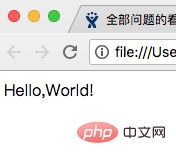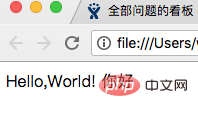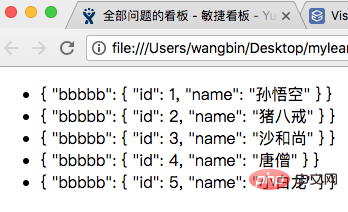Learn about slots in Vue

Vue slots are an indispensable part of learning Vue. When I first came into contact with Vue, I had only a little understanding of these, especially the scope slots.
Later I found the slots more and more useful.
Share some knowledge about slots.
1. Slot content
One sentence: The slot can contain any content.
First look at the following code: declare a child-component component,
If now I want to place some content inside
<div id="app">
<child-component></child-component>
</div>
<script>
Vue.component('child-component',{
template:`
<div>Hello,World!</div>
`
})
let vm = new Vue({
el:'#app',
data:{
}
})
</script><child-component>你好</child-component>
The output content is still the content in the component, and the content written in

We now add a
We are in
Vue.component('child-component',{
template:`
<div>
Hello,World!
<slot></slot>
</div>
`
})
Now, we know what a slot is:
The slot is a set of content distribution API implemented by Vue, which will The
What this sentence means is that if there is no slot, some content in the component tag will not have any effect. When I declare the slot element in the component, in the component element The content written inside will go to it!
2. Named slot
The named slot is to give the slot a name
In the component, I give the slot a name There are three names, one is called "girl", one is called "boy", and one has no name.
Then in
The one without a name is the default slot! !
<div id="app">
<child-component>
<template slot="girl">
漂亮、美丽、购物、逛街
</template>
<template slot="boy">
帅气、才实
</template>
<div>
我是一类人,
我是默认的插槽
</div>
</child-component>
</div>
<script>
Vue.component('child-component',{
template:`
<div>
<h4 id="这个世界不仅有男人和女人">这个世界不仅有男人和女人</h4>
<slot name="girl"></slot>
<div style="height:1px;background-color:red;"></div>
<slot name="boy"></slot>
<div style="height:1px;background-color:red;"></div>
<slot></slot>
</div>
`
})
let vm = new Vue({
el:'#app',
data:{
}
})
</script>3. Scope slot
I never understood what a scope slot is before! ! !
To put it bluntly, it is my attribute on the component, which can be used within the component element!
Let’s look at the simplest example first! !
We define an attribute say on the
We print a and find that it is {"say" : "Hello"}, which is the key-value pair composed of the attributes and values on the slot! ! !
This is the scope slot!
I can use the attributes/values on the component on the component element! !
<div id="app">
<child>
<template slot-scope="a">
<!-- {"say":"你好"} -->
{{a}}
</template>
</child>
</div>
<script>
Vue.component('child',{
template:`
<div>
<slot say="你好"></slot>
</div>
`
})
let vm = new Vue({
el:'#app',
data:{
}
})
</script>Look at the following example again:
<div id="app">
<child :lists="nameList">
<template slot-scope="a">
{{a}}
</template>
</child>
</div>
<script>
Vue.component('child',{
props:['lists'],
template:`
<div>
<ul>
<li v-for="list in lists">
<slot :bbbbb="list"></slot>
</li>
</ul>
</div>
`
})
let vm = new Vue({
el:'#app',
data:{
nameList:[
{id:1,name:'孙悟空'},
{id:2,name:'猪八戒'},
{id:3,name:'沙和尚'},
{id:4,name:'唐僧'},
{id:5,name:'小白龙'},
]
}
})
</script>Look at the output result

##Related recommendations:For more programming-related knowledge, please visit:
2020 Summary of front-end vue interview questions (with answers)
vue tutorial recommendation: 2020 latest 5 vue.js video tutorial selection
Introduction to Programming! !
The above is the detailed content of Learn about slots in Vue. For more information, please follow other related articles on the PHP Chinese website!

Hot AI Tools

Undresser.AI Undress
AI-powered app for creating realistic nude photos

AI Clothes Remover
Online AI tool for removing clothes from photos.

Undress AI Tool
Undress images for free

Clothoff.io
AI clothes remover

Video Face Swap
Swap faces in any video effortlessly with our completely free AI face swap tool!

Hot Article

Hot Tools

Notepad++7.3.1
Easy-to-use and free code editor

SublimeText3 Chinese version
Chinese version, very easy to use

Zend Studio 13.0.1
Powerful PHP integrated development environment

Dreamweaver CS6
Visual web development tools

SublimeText3 Mac version
God-level code editing software (SublimeText3)

Hot Topics
 1662
1662
 14
14
 1418
1418
 52
52
 1311
1311
 25
25
 1261
1261
 29
29
 1234
1234
 24
24
 How to use bootstrap in vue
Apr 07, 2025 pm 11:33 PM
How to use bootstrap in vue
Apr 07, 2025 pm 11:33 PM
Using Bootstrap in Vue.js is divided into five steps: Install Bootstrap. Import Bootstrap in main.js. Use the Bootstrap component directly in the template. Optional: Custom style. Optional: Use plug-ins.
 How to add functions to buttons for vue
Apr 08, 2025 am 08:51 AM
How to add functions to buttons for vue
Apr 08, 2025 am 08:51 AM
You can add a function to the Vue button by binding the button in the HTML template to a method. Define the method and write function logic in the Vue instance.
 How to use watch in vue
Apr 07, 2025 pm 11:36 PM
How to use watch in vue
Apr 07, 2025 pm 11:36 PM
The watch option in Vue.js allows developers to listen for changes in specific data. When the data changes, watch triggers a callback function to perform update views or other tasks. Its configuration options include immediate, which specifies whether to execute a callback immediately, and deep, which specifies whether to recursively listen to changes to objects or arrays.
 What does vue multi-page development mean?
Apr 07, 2025 pm 11:57 PM
What does vue multi-page development mean?
Apr 07, 2025 pm 11:57 PM
Vue multi-page development is a way to build applications using the Vue.js framework, where the application is divided into separate pages: Code Maintenance: Splitting the application into multiple pages can make the code easier to manage and maintain. Modularity: Each page can be used as a separate module for easy reuse and replacement. Simple routing: Navigation between pages can be managed through simple routing configuration. SEO Optimization: Each page has its own URL, which helps SEO.
 How to return to previous page by vue
Apr 07, 2025 pm 11:30 PM
How to return to previous page by vue
Apr 07, 2025 pm 11:30 PM
Vue.js has four methods to return to the previous page: $router.go(-1)$router.back() uses <router-link to="/" component window.history.back(), and the method selection depends on the scene.
 React vs. Vue: Which Framework Does Netflix Use?
Apr 14, 2025 am 12:19 AM
React vs. Vue: Which Framework Does Netflix Use?
Apr 14, 2025 am 12:19 AM
Netflixusesacustomframeworkcalled"Gibbon"builtonReact,notReactorVuedirectly.1)TeamExperience:Choosebasedonfamiliarity.2)ProjectComplexity:Vueforsimplerprojects,Reactforcomplexones.3)CustomizationNeeds:Reactoffersmoreflexibility.4)Ecosystema
 How to use vue traversal
Apr 07, 2025 pm 11:48 PM
How to use vue traversal
Apr 07, 2025 pm 11:48 PM
There are three common methods for Vue.js to traverse arrays and objects: the v-for directive is used to traverse each element and render templates; the v-bind directive can be used with v-for to dynamically set attribute values for each element; and the .map method can convert array elements into new arrays.
 How to reference js file with vue.js
Apr 07, 2025 pm 11:27 PM
How to reference js file with vue.js
Apr 07, 2025 pm 11:27 PM
There are three ways to refer to JS files in Vue.js: directly specify the path using the <script> tag;; dynamic import using the mounted() lifecycle hook; and importing through the Vuex state management library.




